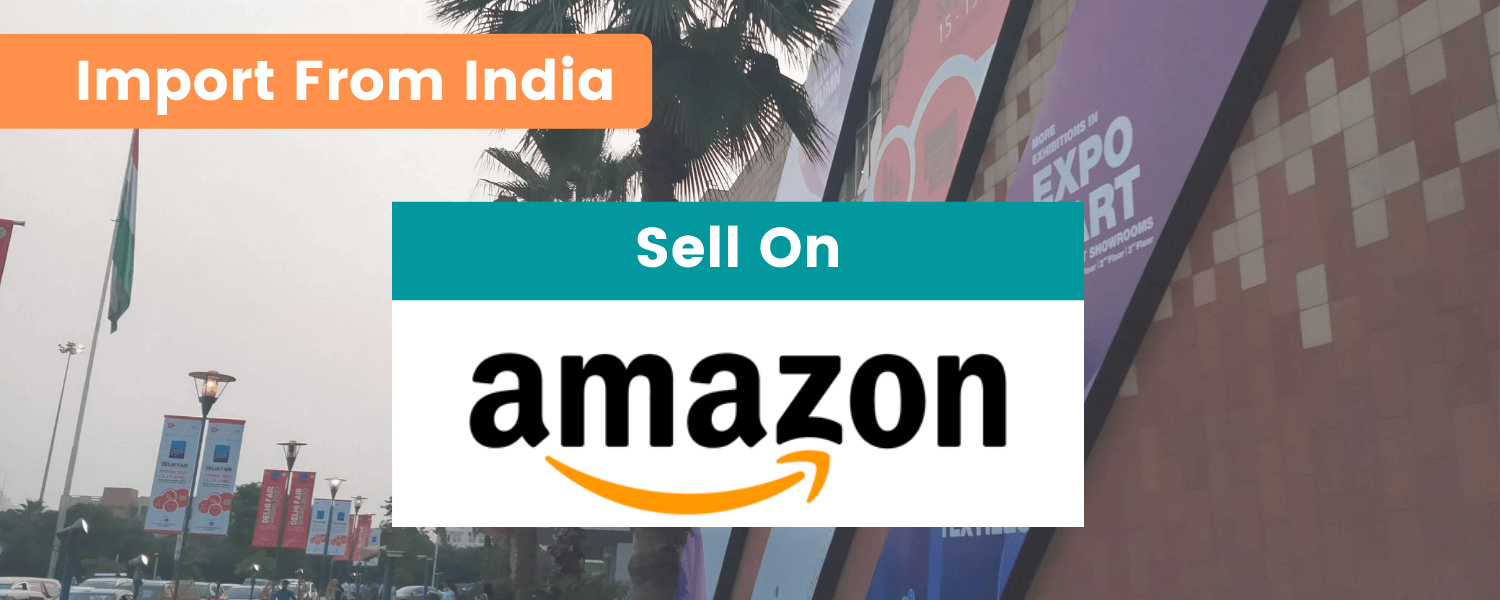Guide to start e-commerce business and source products from India
The growing trend of e-commerce businesses is a fascinating evolution that has been reshaping the landscape of retail and commerce over the past few decades. The rise of e-commerce business can be attributed to several key factors that collectively contribute to its continuous growth and expansion across various sectors. Here are some pivotal elements driving the trend:
- Technological Advancements: The advancement in technology, especially in internet speed, mobile technology, and online payment systems, has made online shopping easier and more accessible. With smartphones becoming ubiquitous, a significant portion of shopping is now done via mobile devices.
- Convenience: E-commerce offers unmatched convenience to consumers. Shoppers can browse products, compare prices, and make purchases from anywhere, at any time, without the need to visit a physical store. This convenience is a major driving force behind the e-commerce boom.
- Personalization and Customer Experience: E-commerce business platforms have the capability to offer personalized shopping experiences to users by utilizing data analytics and artificial intelligence. They can recommend products based on browsing and purchasing history, which enhances the customer experience and increases the likelihood of purchases.
- Global Reach: Unlike traditional brick-and-mortar stores, e-commerce businesses are not limited by geographical boundaries. They can reach customers across the globe, expanding their market potential significantly.
- Reduced Operating Costs: Operating an online store can be less costly than running a physical store, as it often requires less staff, no rental space, and lower overhead costs. This allows e-commerce businesses to offer competitive prices and still maintain healthy profit margins.
- Rise of Social Media and Influencer Marketing: Social media platforms and influencers play a significant role in driving e-commerce business growth. They can introduce products to large audiences, creating trends and increasing demand rapidly.
- Increased Consumer Trust: Over the years, consumers have become more comfortable with making online transactions, thanks to improved security measures, clear return policies, and the reliability of customer reviews. This trust has been critical in encouraging more people to shop online.
- Supply Chain Innovations: Innovations in logistics and supply chain management have enabled faster shipping times, including same-day or next-day delivery for many products. This reduces one of the traditional disadvantages of online shopping – the wait time for product delivery.
- Sustainability and Ethical Shopping: An increasing number of consumers are concerned about sustainability and ethical practices, which has led to the rise of e-commerce business platforms that specialize in sustainable and ethically produced goods.
- Pandemic Impact: The COVID-19 pandemic has accelerated the growth of e-commerce business, as lockdowns and social distancing measures made online shopping not just a convenience, but a necessity for many. This shift in consumer behavior is likely to have lasting effects on the retail landscape.
As we move forward, the e-commerce trend is expected to continue growing, driven by technological advancements, changing consumer behaviors, and innovative business models. This evolution presents both opportunities and challenges for businesses as they adapt to the changing dynamics of commerce in the digital age.
Sourcing products from India offers a range of benefits to businesses across the globe. This is largely due to India’s unique position in the global market, which is characterized by its vast and diverse manufacturing sector, skilled labor force, and rich natural resources. Here are some of the key benefits of sourcing products from India:
- Cost-Effectiveness: One of the primary advantages of sourcing from India is the cost-effectiveness of both labor and materials. The country has a large, skilled workforce that commands lower wages compared to many Western countries. This, combined with lower operational costs, allows businesses to procure goods at a significantly lower cost without compromising on quality. This cost advantage makes India an attractive sourcing destination for a wide range of products, from textiles to electronics.
- Quality Products: India has a long-standing reputation for producing high-quality goods, especially in industries like textiles, jewelry, leather, and handicrafts. Indian manufacturers adhere to international quality standards, and many have obtained certifications such as ISO, which further assures buyers of the quality of products they are sourcing. The country’s emphasis on quality improvement and compliance with global standards makes it a reliable source for quality products.
- Diverse Range of Products: India’s manufacturing sector is incredibly diverse, offering a wide array of products across various industries. From traditional products like spices, teas, and handicrafts to modern goods like pharmaceuticals, chemicals, and machinery, India’s product range is vast and varied. This diversity enables buyers to source multiple product categories from the country, simplifying logistics and procurement processes.
- Strong Focus on Innovation and Technology: India has been making significant strides in technology and innovation, particularly in industries such as pharmaceuticals, information technology, and auto components. This focus on innovation ensures that products sourced from India often meet high standards of technology and innovation, making it a competitive source for technically advanced products.
- Flexibility in Production: Indian manufacturers are known for their flexibility in terms of minimum order quantities and the ability to customize products according to buyer specifications. This flexibility is particularly beneficial for small and medium-sized enterprises (SMEs) that may not have the large order volumes typically required by manufacturers in other countries.
- Strategic Geographic Location: India’s strategic location, bordered by the Indian Ocean, the Arabian Sea, and the Bay of Bengal, provides easy access to markets in Europe, the Middle East, Africa, and Asia. This geographical advantage is complemented by a well-established network of ports and logistics infrastructure, facilitating efficient shipping and handling of goods.
- Government Support and Initiatives: The Indian government has implemented various initiatives to boost trade and ease the process of doing business with foreign entities. Programs like “Make in India” aim to establish India as a global manufacturing hub by encouraging foreign investment and reducing bureaucratic hurdles. Such initiatives create a conducive environment for sourcing from India.
- Rich Cultural Heritage and Artisanal Goods: India’s rich cultural heritage is reflected in its artisanal goods, which are highly valued in international markets. Products like handwoven textiles, traditional jewelry, and unique handicrafts offer an unmatched blend of cultural richness and craftsmanship. Sourcing these products provides businesses with unique offerings that cater to the growing consumer demand for culturally inspired and artisanal goods.
In conclusion, sourcing from India can offer businesses a competitive edge through cost-effectiveness, quality, diversity, and innovation. As India continues to grow as a global sourcing destination, businesses can leverage these benefits to enhance their product offerings and achieve cost efficiencies.
Why Choose India for Sourcing Products?

India’s diversity in products is as vast and varied as its cultural and geographical landscape. The country’s extensive range of goods stems from its rich natural resources, a wide variety of climates, centuries-old traditions, and a burgeoning modern industry. This diversity not only caters to the domestic market but also positions India as a significant player in the global market across several product categories:
Agricultural Products
India is one of the world’s largest producers of agricultural products, thanks to its fertile land and diverse climate. Key products include rice, wheat, spices (India is often called the land of spices), tea (Assam and Darjeeling tea are internationally renowned), and an array of fruits and vegetables. India is also the largest producer of milk globally.
Textiles and Garments
The Indian textile industry is one of the oldest in the world, renowned for its fine craftsmanship and rich fabrics. It includes a wide variety of cotton, silk, wool, and synthetic fabrics. India is famous for its traditional handloom fabrics, embroidered works, and vibrant prints. Products range from everyday wear to exquisite sarees and intricate bridal wear, catering to both domestic and international markets.
Jewelry and Gemstones
India has a long history of jewelry making and is one of the largest exporters of gemstones and jewelry. The country is known for its intricate gold jewelry, diamond cutting, and precious stones like sapphires, emeralds, and rubies. Indian craftsmanship in jewelry is highly valued for its quality and design.
Leather Products
India is a significant player in the leather industry, known for its high-quality leather goods such as shoes, bags, belts, and jackets. The country’s leather industry benefits from a large domestic supply of raw materials and skilled craftsmanship.
Handicrafts and Artisan Goods
India’s rich cultural heritage is reflected in its diverse range of handicrafts, including pottery, woodwork, metalwork, textiles, and painting. Each region in India has its own unique handicraft traditions, making Indian handicrafts highly sought after for their cultural value and craftsmanship.
Pharmaceuticals
India is known as the “pharmacy of the world” for its significant role in producing generic drugs. The country offers a wide range of pharmaceutical products, including active pharmaceutical ingredients (APIs) and formulations. The Indian pharmaceutical industry is known for its high-quality standards and cost-effectiveness.
Information Technology Products and Services
India has emerged as a global hub for information technology (IT) and software services, including software development, IT consulting, and BPO services. The country’s IT sector is known for its innovation, quality, and cost-effective solutions.
Automobiles and Auto Components
India’s automobile industry has grown significantly, with the country being a large producer of passenger vehicles, commercial vehicles, and two-wheelers. It is also a significant exporter of auto components, supplying to major automotive manufacturers worldwide.
Food and Beverages
The diversity of Indian cuisine is well-represented in its food and beverage products. This includes a variety of packaged foods, spices, condiments, snacks, and ready-to-eat meals. Indian beverages like tea, coffee, and an assortment of traditional drinks are also popular globally.
Renewable Energy Equipment
With a strong focus on sustainable development, India is rapidly growing in the renewable energy sector, especially in solar and wind energy. The country manufactures a range of renewable energy equipment, including solar panels and wind turbines.
The diversity of products available in India is a testament to its rich natural resources, diverse cultures, and strong industrial capabilities. This diversity not only meets the varied demands of the global market but also contributes significantly to India’s economy.
Indian goods offer a compelling combination of cost benefits and quality, making them attractive to both domestic and international markets. Here’s how India manages to strike this balance:
- Lower Labor Costs: One of the most significant cost advantages is the lower labor cost in India compared to many Western countries. The availability of a large, skilled, and semi-skilled workforce at competitive wages allows for the production of goods at lower costs.
- Economies of Scale: India’s large domestic market provides manufacturers with the opportunity to achieve economies of scale, reducing the cost per unit of production. This benefit is particularly pronounced in industries like textiles, pharmaceuticals, and automobiles.
- Government Policies and Support: The Indian government has implemented various policies and schemes to support manufacturing and exports, including subsidies, tax exemptions, and special economic zones (SEZs). These measures reduce the cost burden on manufacturers and exporters, enabling them to offer competitive pricing.
- Raw Material Availability: India is rich in natural resources and raw materials required for various industries, including agriculture, textiles, and jewelry. Local availability reduces the costs related to raw materials sourcing and transportation.
Quality of Indian Goods
- Adherence to International Standards: Indian manufacturers have increasingly focused on quality, adhering to international standards and obtaining certifications like ISO, CE, and GMP. This ensures that the products meet global quality requirements.
- Skilled Craftsmanship: India has a long tradition of craftsmanship in fields such as textiles, jewelry, and handicrafts. This skilled craftsmanship, passed down through generations, results in products of high quality and unique artistic value.
- Innovation and Technology: India has made significant strides in incorporating innovation and technology in manufacturing. From pharmaceuticals to information technology, Indian products are often at the forefront of innovation, enhancing their quality and global competitiveness.
- Quality Control Mechanisms: Many Indian companies have implemented stringent quality control mechanisms throughout the production process. This includes regular inspections, testing, and continuous process improvements to ensure that the final products meet the required quality standards.
- Global Recognition: The quality of Indian goods is recognized globally, with many sectors like pharmaceuticals, textiles, and IT services being leaders in their respective fields. Indian products have established a strong reputation in international markets for their durability, performance, and craftsmanship.
The combination of cost benefits and quality makes Indian goods highly competitive on the global stage. Businesses sourcing from India can leverage these advantages to enhance their product offerings while maintaining profitability. This balance of cost and quality has contributed to India’s growing prominence as a global sourcing and manufacturing hub.

Understanding the Indian Market
Navigating the Indian market and finding reliable suppliers can be a rewarding venture given India’s vast economic diversity and manufacturing capabilities. Here are insights and strategies to help you find reliable suppliers in India:
- Diverse Economic Sectors: India’s economy is diverse, encompassing agriculture, textiles, technology, pharmaceuticals, and much more. Understanding which regions specialize in your desired products can lead to more focused and successful supplier searches.
- Regional Specializations: Different regions of India specialize in different industries. For example, Tamil Nadu is known for its textiles, Punjab for agricultural products, and Gujarat for diamonds and chemicals. Targeting your search based on these specializations can improve efficiency.
- Market Dynamics: The Indian market is characterized by both organized and unorganized sectors. While larger manufacturers might be part of the organized sector, small-scale suppliers and artisan communities form a significant part of the unorganized sector, offering unique products.
Finding Reliable Suppliers
- Trade Fairs and Exhibitions: India hosts numerous trade fairs and exhibitions across various industries. Events like the India International Trade Fair, Jewellery shows, and Textile Fairs are excellent opportunities to meet suppliers, examine their products firsthand, and establish business relationships.
- B2B Marketplaces: Online B2B marketplaces such as IndiaMART, TradeIndia, and Alibaba have numerous Indian suppliers listed across different product categories. These platforms allow you to review suppliers’ profiles, product offerings, and customer feedback.
- Government and Trade Associations: Engaging with Indian government trade departments and industry-specific associations can provide valuable insights and introductions to reputable suppliers. Organizations like the Federation of Indian Export Organisations (FIEO) can be instrumental in connecting buyers with reliable exporters.
- Due Diligence: Conducting thorough due diligence is crucial when selecting suppliers. This includes verifying company registrations, financial health, production capabilities, and compliance with quality standards. Requesting samples and conducting factory visits, if possible, are also key steps in assessing potential suppliers.
- References and Testimonials: Ask for references and testimonials from existing clients of the supplier. This can provide real insights into the supplier’s reliability, product quality, and business practices.
- Partnerships and Collaboration: Building long-term relationships based on mutual benefit and trust can lead to more reliable and stable supply chains. Transparent communication and understanding cultural nuances can enhance these partnerships.
- Legal Agreements: Ensure all agreements with suppliers are documented in legally binding contracts. These should clearly outline product specifications, quality requirements, delivery timelines, payment terms, and dispute resolution mechanisms.
- Local Assistance: Consider hiring a local agent or consultant who understands the Indian market and can assist in finding and vetting suppliers. Their expertise and local knowledge can be invaluable in navigating the market complexities.
Navigating Challenges
- Cultural Differences: Be aware of cultural differences in business practices and negotiations. Building personal relationships and respect is often as important as the business transaction itself.
- Quality Consistency: While Indian suppliers are capable of producing high-quality goods, maintaining consistency can be a challenge, especially with smaller suppliers. Regular quality checks and clear communication of expectations are essential.
- Logistics and Shipping: India’s vast geography and infrastructural bottlenecks can sometimes lead to logistical challenges. Working with experienced logistics partners and planning for potential delays can mitigate these issues.
Understanding the dynamics of the Indian market and employing strategic measures to find and assess suppliers can lead to successful sourcing from India. With its vast and varied production capabilities, India offers immense opportunities for global businesses looking to enhance their product offerings and competitiveness.
Navigating cultural nuances, employing effective negotiation tactics, and building strong relationships are crucial skills for conducting successful business, especially in diverse and complex markets like India. Understanding and respecting cultural differences can significantly influence the outcome of business negotiations and the quality of business relationships.
Cultural Nuances in India
- Respect for Hierarchy: Indian society places a strong emphasis on hierarchy and respect for authority. It’s important to acknowledge the seniority of the individuals you are dealing with in business settings, both in how you address them and in your communication style.
- Importance of Relationships: Building personal relationships is key to doing business in India. Indian business culture values trust and personal rapport, which often precedes formal business dealings. Taking the time to engage in small talk and showing interest in your counterparts’ personal life can be as important as the business discussion itself.
- Indirect Communication: Communication in India can be indirect, with a tendency to avoid confrontation or saying ‘no’ directly. It’s important to read between the lines and understand that reluctance or hesitation may indicate disagreement or inability to meet a request.
- Flexibility and Patience: Time perception can be more flexible in India compared to Western countries. Meetings may start or end later than scheduled, and decision-making can be a slow process, requiring patience and adaptability.
- Negotiation Style: Negotiations in India can be lengthy, with a lot of back-and-forth discussions. Price negotiations are common, and it’s expected that there will be some compromise from both sides. Demonstrating respect and patience during these discussions is vital.
Negotiation Tactics
- Preparation: Understand the market and the typical business practices in your industry in India. Being well-informed can significantly strengthen your negotiation position.
- Build Relationships First: Invest time in building a rapport with your Indian counterparts before diving into business negotiations. Relationships are often the foundation of trust and successful negotiations.
- Be Clear but Flexible: Clearly articulate your expectations and limits, but show flexibility in how these can be achieved. Being too rigid can hamper negotiations.
- Use Local Expertise: Consider engaging a local intermediary or consultant who understands the local business culture and can navigate negotiations more effectively.
- Patience is Key: Be prepared for negotiations to take longer than you might expect. Patience and persistence are important in achieving favorable outcomes.
Building Relationships
- Personal Interaction: Face-to-face meetings are highly valued in India and can be more effective than virtual communications for building strong relationships.
- Understand the Cultural Context: Showing appreciation for Indian culture, traditions, and festivals can enhance personal connections and show respect for your counterparts’ background.
- Follow-up and Consistency: Regular communication and follow-ups after meetings and agreements are important to maintain the momentum of the business relationship.
- Mutual Respect and Trust: Demonstrate respect for your counterparts’ expertise and insights. Building mutual trust is crucial for long-term business relationships.
- Adaptability: Be willing to adapt your business practices and communication style in consideration of cultural differences. This flexibility can go a long way in building solid relationships.
Understanding and adapting to these cultural nuances and employing effective negotiation strategies are crucial for success in the Indian market. The emphasis on building personal relationships, coupled with patience and respect for local business practices, can lead to fruitful long-term partnerships.

Steps to Build Your E-Commerce Store
Step 1: Define Your Business Model and Target Audience
- Business Model: Decide whether you’ll be selling your own products, dropshipping, or using a print-on-demand service. Each model has its own set of challenges and benefits.
- Target Audience: Understand who your customers are. Knowing your target audience influences your marketing strategy, product selection, and the overall design of your website.
- Considerations: Look for a platform that fits your business size, technical skills, and budget. Key features to consider include payment processing options, integrations with other tools, scalability, and support.
- Popular Platforms: Shopify, WooCommerce (for WordPress sites), Magento, and BigCommerce are among the most popular. Shopify and BigCommerce are great for beginners due to their ease of use, while WooCommerce and Magento offer more customization for those with web development experience.
- Domain Name: Choose a unique and memorable domain name that reflects your brand. Use domain name registrars like GoDaddy, Namecheap, or the domain service provided by your e-commerce platform.
- Hosting: If your platform is self-hosted like WooCommerce, you’ll need to choose a reliable web hosting service. Managed e-commerce platforms like Shopify and BigCommerce include hosting.
Setting up an eCommerce site using Astra and WooCommerce involves a few systematic steps to ensure your online store is visually appealing, functional, and ready to welcome customers. Here’s a step-by-step guide:
1. Install WordPress
- Via Hosting Provider:
Most hosting services offer a one-click WordPress installation feature. Here is a link to wordpress installation - Manually: Download WordPress from the official website and follow the installation instructions.
2. Install the Astra Theme
- Navigate to your WordPress dashboard.
Go to Appearance > Themes > Add New. - Search for Astra and click Install, then Activate.
3. Install Starter Templates
- Starter Template provides pre-built website templates that you can import to get started quickly.
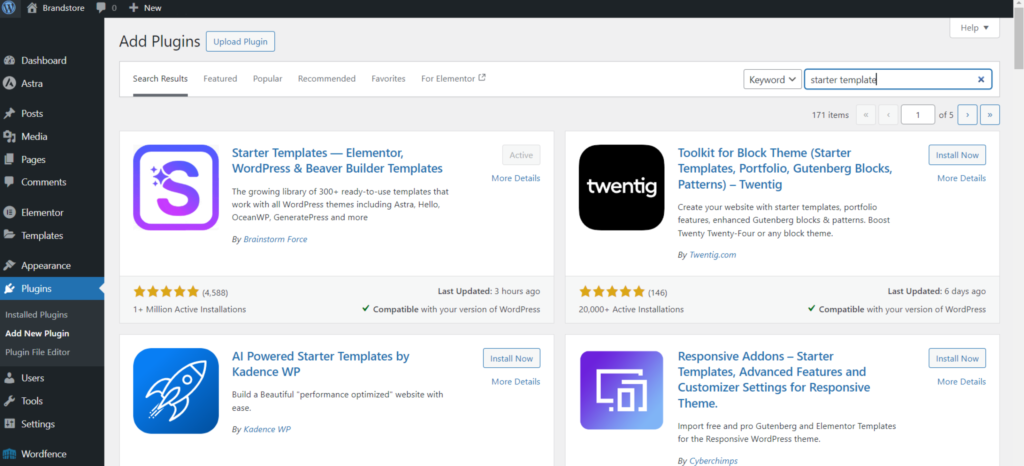
- Install and activate the Starter Templates plugin from Plugins > Add New.
- Once activated, go to Plugins > Starter Templates and select your preferred page builder (e.g., Elementor, Beaver Builder).
- Browse the templates and choose one that suits your eCommerce needs.
- 4. Install WooCommerce
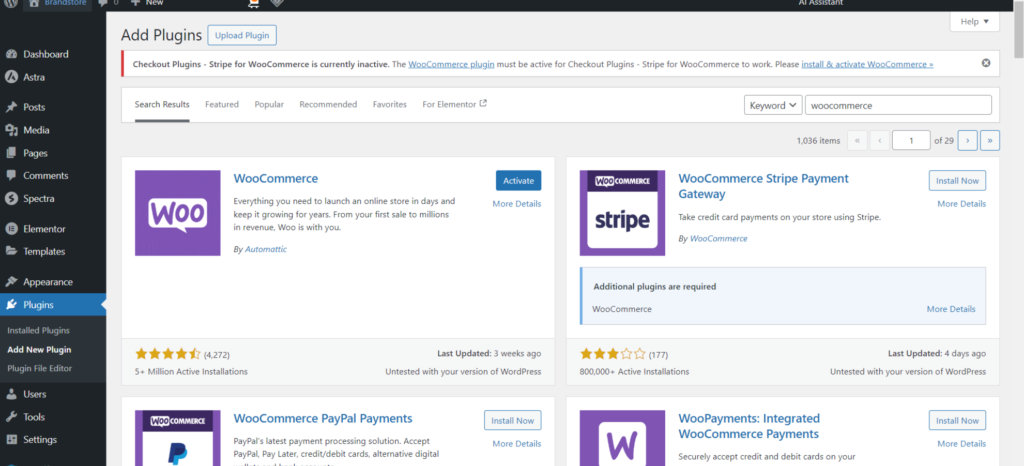
- Go to Plugins > Add New. Search for WooCommerce.
- Click Install Now, then Activate.
- 5. Set Up WooCommerce
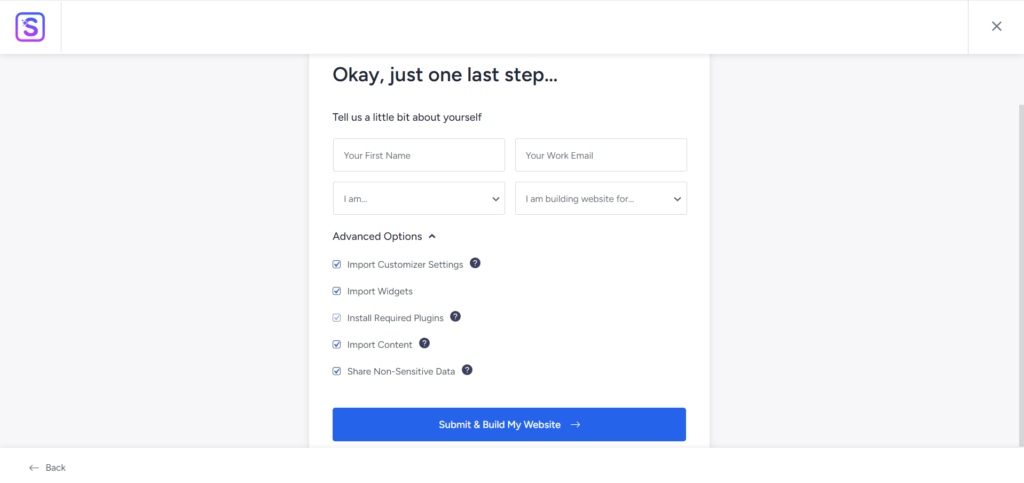
- After activation, WooCommerce will launch a setup wizard to help you configure the basics:
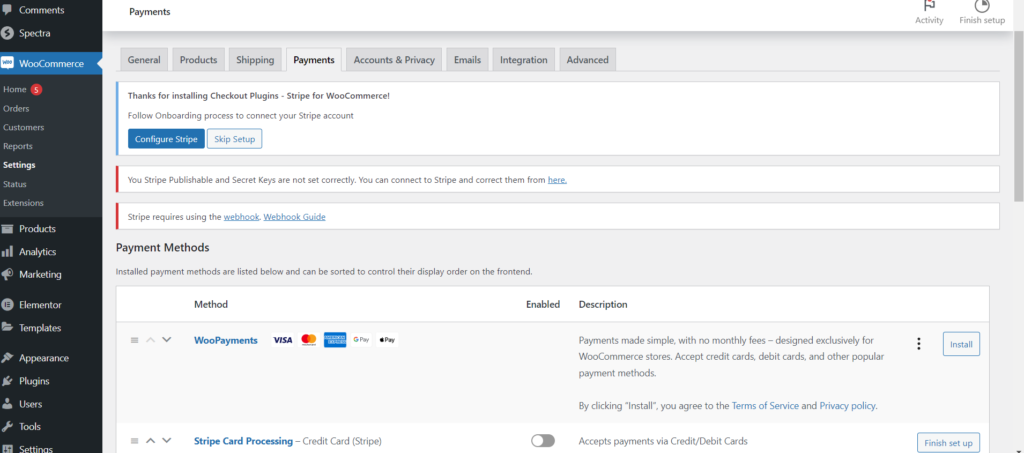
- To set up a detailed payment method for a WooCommerce site, you can follow these steps:
- i. Access Payment Settings: – Log into your WordPress dashboard. – Navigate to WooCommerce and select Settings. – Go to the Payments tab.
- ii. Choose Payment Methods: – WooCommerce comes with several built-in payment options such as Direct Bank Transfer (BACS), Check Payments, Cash on Delivery, and PayPal. – Click Set up or Manage next to the payment method you wish to configure. If you want to add more options like credit cards or specific gateways (e.g., Stripe, Square), you may need to install additional plugins.
- iii. Install Additional Payment Gateways: – Go to Plugins > Add New and search for the payment gateway plugin you want to add (e.g., Stripe, PayPal Pro). – Install and activate the plugin. – Once activated, configure the gateway by going back to the ‘Payments’ tab in WooCommerce settings.
- iv. Configure Payment Gateway: – Each payment gateway has different settings. Common settings include enabling the gateway, adding titles and descriptions that show up during checkout, and entering gateway-specific credentials such as API keys. – For example, if you’re setting up Stripe: – Enable Stripe by toggling it on. – Enter the publishable key and secret key which you can obtain from your Stripe account. – Configure other settings like transaction methods, card icons, and whether to save customer info.
- v. Testing: – Before going live, use the payment gateway’s test mode to make sure everything works as expected. Most gateways provide test credentials for this purpose. – Conduct test transactions to check if the payment process is smooth and secure.
- vi. Going Live: – Once testing is completed, switch from test mode to live mode by updating the credentials and settings. – Ensure that all your payment methods are properly configured and enabled.
- vii. Additional Configurations and Security: – Consider setting up SSL certification for your site to encrypt data, which is especially important for handling payments securely. – Configure additional options such as payment restrictions based on location, or automatic email notifications upon successful payment.
- viii. Maintain Compliance: – Make sure to comply with PCI standards and local regulations regarding online payments. – Provide clear terms and conditions on your site related to payment processing. By following these steps, you can effectively set up and manage a range of payment methods on your WooCommerce site, ensuring a seamless and secure checkout experience for your customers.
6. Add Products
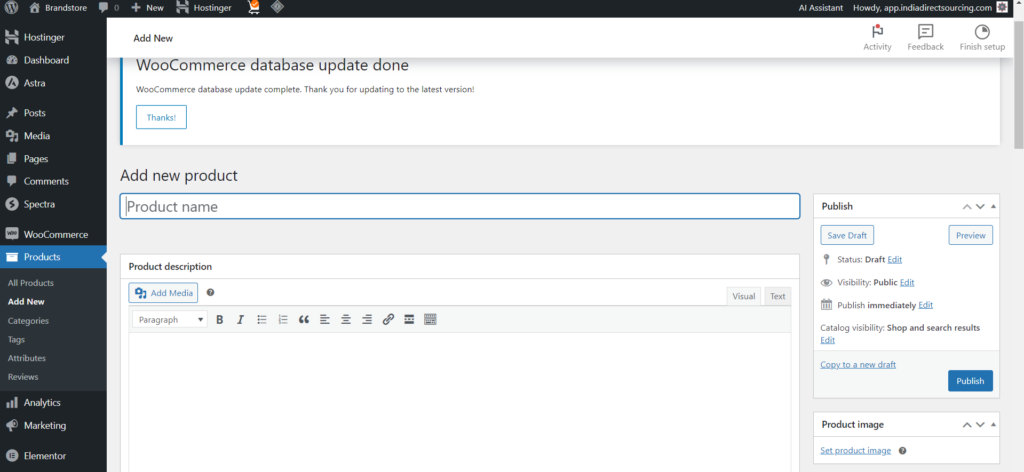
- Navigate to Products > Add New.
Fill in the product details, including name, description, price, and images.
Assign categories and tags, then publish.
7. Customize Your Store
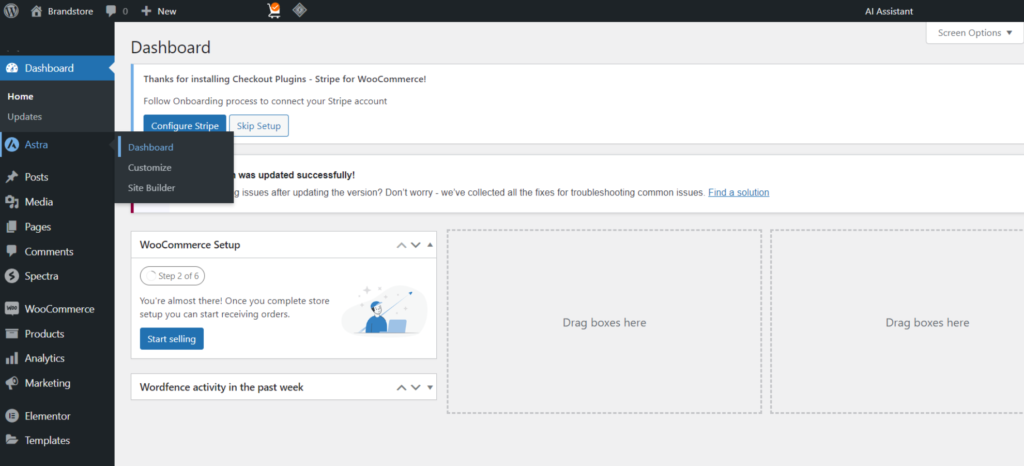
- With Astra: Go to Astra > Customize. Astra allows you to adjust headers, footers, layout, colors, and more.

- WooCommerce Settings: Go to WooCommerce > Settings to fine-tune your store’s functionalities, like inventory management, emails, checkout options, etc.
8. Install Additional Plugins (Optional)
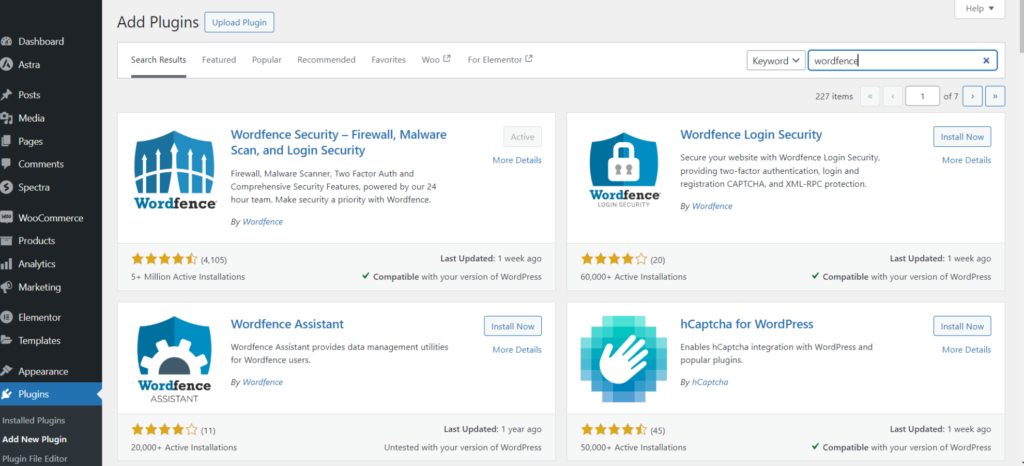
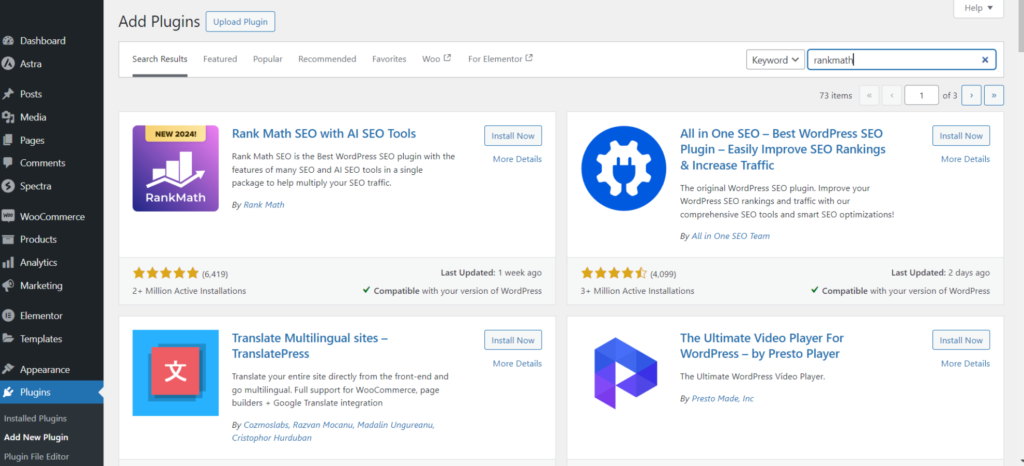
- Consider adding plugins such as Rank Math, Wordfence etc for SEO, security, marketing, and analytics to enhance your store’s capabilities and performance.
9. Test Your Store
- Before going live, thoroughly test your store:
Place test orders.
Navigate through the site as a customer. - Check mobile responsiveness.
Ensure all links and buttons work correctly.
10. Launch Your Store
- After testing and final adjustments, your eCommerce store is ready to go live. Promote your store through various channels to attract customers.
Step 5: Add Your Products
- Product Listings: Include high-quality images and detailed descriptions for each product. Use SEO-friendly titles and descriptions to improve visibility on search engines.
- Categories and Organization: Organize your products into categories to make it easier for customers to find what they’re looking for.
Step 6: Set Up Payment Processing
- Payment Options: Offer multiple payment options to accommodate different preferences. Most e-commerce platforms support integrations with various payment gateways like PayPal, Stripe, and credit card processors.
- Security: Ensure your website is SSL certified to encrypt data and protect your customers’ information.
Step 7: Implement Shipping and Fulfillment Strategies
- Shipping Options: Decide on your shipping strategy—whether you’ll offer free shipping, flat-rate shipping, or variable rates based on weight or geography. Consider using shipping software to automate and streamline the process.
- Fulfillment: If you’re not fulfilling orders yourself, choose a reliable fulfillment partner. Some e-commerce platforms offer built-in fulfillment services, or you can use third-party logistics providers.
Step 8: Launch Your Website
- Testing: Before launching, thoroughly test your website. Check for any broken links, ensure the checkout process is smooth, and confirm that all payment options work as expected.
- Launch: Once you’re confident everything is in place, launch your website. Use social media, email marketing, and other channels to announce the launch to your target audience.
Step 9: Marketing and SEO
- SEO: Optimize your website for search engines to increase visibility. Include relevant keywords in your product descriptions, blog content, and meta tags.
- Marketing: Leverage social media, email marketing, content marketing, and paid advertising to attract and retain customers.
Step 10: Analyze and Optimize
- Analytics: Use tools like Google Analytics to track your website’s performance. Monitor metrics such as traffic, conversion rate, and average order value to understand customer behavior.
- Optimization: Based on analytics insights, continuously optimize your website and marketing strategies to improve performance and grow your business.
Starting an e-commerce store requires careful planning and execution, but by following these steps, you can create a strong foundation for a successful online business. Remember, the key to success lies in understanding your audience, offering quality products, and providing an excellent shopping experience
How to Source Products from India
Sourcing products from India involves navigating a complex landscape of cultural practices, logistical challenges, and regulatory requirements. However, with a strategic approach, you can establish a successful sourcing operation that leverages India’s manufacturing prowess and cost advantages. Here’s how to navigate the logistics of sourcing products from India, including communication tips, payment methods, and shipping logistics.
1. Research and Identify Potential Suppliers
- Trade Fairs and Online Marketplaces: Attend industry-specific trade fairs in India or utilize online B2B marketplaces like IndiaMART, TradeIndia, and Alibaba to find potential suppliers.
- Industry Associations: Contact industry associations for recommendations on reputable suppliers.
- Factory Audits and Site Visits: Conduct factory audits and site visits, if possible, to assess the supplier’s capabilities, quality control processes, and labor conditions.
2.Communication Tips
- Cultural Sensitivity: Understand and respect Indian business etiquette. Personal relationships and trust are crucial, so invest time in getting to know your suppliers.
- Clarity and Detail: Be clear and detailed in your communications. Specify product specifications, quality standards, and timelines to avoid misunderstandings.
- Patience and Follow-Up: Be patient and expect some back-and-forth negotiation. Regular follow-ups are important to keep things moving and to demonstrate your commitment.
3.Negotiating Terms
- Price Negotiation: Be prepared for negotiation on prices. Knowing the local market price for your products can give you a better negotiating position.
- Payment Terms: Discuss and agree on payment terms that are secure for both parties. Common terms include advance payment, Letters of Credit (LCs), and Net 30/60/90 day terms.
- Quality Assurance: Define quality requirements clearly and discuss how they will be assessed and ensured. Agree on quality control processes and who will bear the costs of rework or rejects.
4.Payment Methods
- Advance Payment: Often required by suppliers for first-time orders. It’s riskier for the buyer, so it’s usually limited to smaller amounts.
- Letters of Credit: Widely used for international trade. It offers security to both parties, as payment is only made when the terms of the LC are met.
- Bank Transfers: Simple and quick, but carries risk if you’re not familiar with the supplier. Use for trusted partners only.
- Trade Credit Insurance: Consider using trade credit insurance to protect against non-payment by foreign buyers.
5.Shipping Logistics
- Incoterms: Understand International Commercial Terms (Incoterms) to determine the shipping and delivery responsibilities between you and the supplier.
- Freight Forwarder: Engage a reliable freight forwarder or logistics company experienced in India’s export regulations and international shipping. They can handle customs clearance, documentation, and transportation.
- Shipping Method: Choose between air freight (faster but more expensive) and sea freight (cost-effective for bulk orders but slower). Consider the balance between cost and delivery time based on your inventory needs.
- Customs and Duties: Be aware of the customs regulations and duty rates in your country for the products you’re importing from India. A customs broker can help navigate these regulations.
6.Regulatory Compliance and Documentation
- Compliance: Ensure your products comply with both Indian export regulations and the import regulations of your country. This includes safety standards, labeling requirements, and environmental regulations.
- Documentation: Obtain the necessary documentation from your supplier, such as a commercial invoice, packing list, certificate of origin, bill of lading (B/L), and any required inspection certificates.
Building Long-Term Relationships
- Mutual Respect and Understanding: Foster a relationship built on mutual respect and understanding. Show appreciation for your supplier’s expertise and work towards a partnership that benefits both parties.
- Regular Communication: Maintain regular communication to discuss challenges, review performance, and plan for future orders. This helps in identifying potential issues early and finding solutions together.
Sourcing from India can offer significant advantages in terms of cost, quality, and variety. However, success requires thorough research, careful planning, and ongoing management of supplier relationships and logistics. By understanding and respecting the local business culture, and by establishing clear communication and reliable logistic practices, businesses can build fruitful, long-term partnerships with Indian suppliers.
For more insights do check out our post on The Financial Model for Amazon FBA Business: A Comprehensive Guide
Legal and Regulatory Considerations
Ensuring compliance when importing goods from India involves navigating a series of legal and regulatory requirements. These steps are crucial to avoid costly delays, penalties, and potential legal issues. Below is an outline of the necessary legal and regulatory steps to take:
1.Understand Import Regulations in Your Country
- Customs Regulations: Familiarize yourself with your country’s customs regulations regarding imports from India. This includes prohibited items, restrictions, and special requirements for certain types of goods.
- Safety and Quality Standards: Ensure the products you import comply with safety and quality standards in your market. This might include certifications, testing, and labeling requirements specific to your industry (e.g., electronics, pharmaceuticals, food products).
2.Determine Tariff Classifications and Duties
- Harmonized System (HS) Code: Determine the correct HS code for your products. The HS code is a standardized numerical method of classifying traded products and is used by customs authorities around the world to assess duties and taxes.
- Duties and Taxes: Based on the HS code, determine the applicable import duties and taxes. This will affect your cost calculations and pricing strategy.
3.Obtain Necessary Licenses and Permits
- Depending on the type of goods you’re importing from India, you may need specific licenses or permits. For example, importing agricultural products, pharmaceuticals, or chemicals often requires approval from relevant regulatory bodies in your country.
4.Ensure Compliance with Intellectual Property Rights (IPR)
- Verify that the goods you import do not infringe on intellectual property rights in your country. This includes checking for potential patent, trademark, or copyright issues, especially for branded goods or items with specific designs.
5.Engage with Competent Authorities for Product-Specific Regulations
- Product-Specific Regulations: Some products may be subject to additional regulations and standards. Engage with the competent regulatory authorities to ensure compliance. For instance, electronics may need to meet electromagnetic compatibility (EMC) standards, while food products might require health and safety certifications.
6.Compliance Documentation
- Commercial Invoice: This document should detail the transaction between the exporter and importer, including a description of the goods, terms of sale, and pricing.
- Packing List: Provides details about the packaging of the goods being imported.
- Certificate of Origin: Verifies the country in which the goods were manufactured. This may affect the duties and taxes applied.
- Bill of Lading or Air Waybill: Legal documents issued by the carrier to acknowledge receipt of cargo for shipment.
- Compliance Certificates: Depending on the product, certificates proving compliance with relevant safety, health, or environmental standards may be required.
7.Customs Clearance
- Customs Broker: Consider hiring a customs broker to navigate the complexities of the import process. They can help with tariff classifications, tax and duty calculations, and ensuring all documentation is in order for customs clearance.
- Inspection and Compliance Checks: Be prepared for possible inspections by customs authorities to verify the compliance of the goods with local regulations. This may include checks on documentation, product safety, and quality standards.
8.Monitor Compliance of Suppliers
- Regularly monitor and audit your Indian suppliers to ensure ongoing compliance with both Indian export regulations and your country’s import regulations. This includes ensuring they maintain the necessary certifications and adhere to the agreed-upon quality standards.
9.Stay Informed on Trade Agreements
- Bilateral and Multilateral Trade Agreements: Be aware of any trade agreements between your country and India that may affect tariffs, taxes, and regulatory requirements. Such agreements can provide preferential treatment and simplified customs procedures.
10.Ethical and Environmental Compliance
- Beyond legal requirements, consider ethical and environmental standards. This may include ensuring that goods are produced under fair labor conditions and that environmental regulations are respected.
By carefully following these steps and staying informed about both your country’s import regulations and India’s export laws, you can ensure a compliant and efficient import process. It’s also advisable to consult with trade experts or legal advisors specializing in international trade law to navigate any complex regulatory issues effectively.
Marketing Your E-Commerce Store
Marketing an e-commerce business store that specializes in Indian-sourced products offers a unique opportunity to leverage the rich cultural heritage, quality, and diversity of goods from India. Here are strategies tailored to effectively market such a store and create a distinctive brand identity:
1.Tell the Story Behind the Products
- Craftsmanship and Heritage: Highlight the craftsmanship, traditions, and stories behind your products. Content that educates customers about the artisan communities, manufacturing processes, or cultural significance can add value and create emotional connections.
- Product Videos and Blogs: Use videos and blogs to showcase the making of the products, interviews with artisans, and behind-the-scenes looks at the production process.
2.Leverage Social Media
- Visual Platforms: Utilize visually rich social media platforms like Instagram, Pinterest, and Facebook to showcase the vibrant aesthetics of Indian products. High-quality images and videos can capture the attention of potential customers.
- Influencer Partnerships: Collaborate with influencers who align with your brand values and can authentically promote your products to their followers. Influencers with a focus on sustainable living, fashion, or cultural appreciation can be particularly effective.
3.Focus on SEO and Content Marketing
- Niche Keywords: Optimize your website and content for SEO by targeting niche keywords related to Indian products, crafts, and cultural items. This can help attract organic traffic from potential customers interested in authentic Indian goods.
- Educational Content: Create blog posts, videos, and infographics that educate your audience about Indian culture, festivals, and traditions related to your products. This type of content can improve SEO and engagement.
4.Offer a Seamless Shopping Experience
- User-Friendly Website: Ensure your website is easy to navigate, mobile-friendly, and quick to load. A well-designed site with clear categories, detailed product descriptions, and an easy checkout process can significantly enhance the customer experience.
- Personalization: Use personalization techniques such as product recommendations based on browsing history or personalized email marketing to make the shopping experience more relevant and engaging for customers.
5.Utilize Email Marketing
- Newsletter Subscriptions: Encourage customers and site visitors to subscribe to your newsletter. Use this channel to share new arrivals, stories behind the products, special offers, and content that educates about Indian culture.
- Segmentation and Personalization: Segment your email list based on customer interests, purchase history, and behavior. Send personalized emails that cater to the preferences of different segments to increase engagement and conversions.
6.Implement a Loyalty Program
- Rewards for Repeat Purchases: Create a loyalty program that rewards customers for repeat purchases, referrals, and social shares. This can enhance customer retention and encourage word-of-mouth marketing.
- Exclusive Offers: Provide members of your loyalty program with exclusive offers, early access to new products, and special gifts to foster a sense of belonging and appreciation.
7.Tap into Cultural and Festival Marketing
- Cultural Festivals: Leverage Indian festivals and cultural events as opportunities for special promotions and themed marketing campaigns. For example, offer special discounts or curate product collections for Diwali, Holi, and other significant festivals.
- Collaborate with Cultural Organizations: Partner with cultural organizations or participate in community events to increase brand visibility among audiences interested in Indian culture.
8.Provide Excellent Customer Service
- Responsive Support: Offer quick and helpful customer support through various channels like live chat, email, and social media. Positive customer service experiences can lead to favorable reviews and repeat business.
- Feedback Loop: Encourage and analyze customer feedback to continuously improve your product offerings and customer service practices.
By combining these strategies, you can effectively market your e-commerce store that sells products sourced from India. Highlighting the uniqueness of your products, leveraging digital marketing techniques, and providing a personalized shopping experience are key to attracting and retaining customers.
Conclusion
Starting an e-commerce business with products sourced from India can offer a unique value proposition due to the country’s rich diversity, craftsmanship, and cost-effective manufacturing. Here’s a recap of the benefits followed by a step-by-step guide to getting started.
Benefits of Sourcing Products from India:
- Cost-Effectiveness: Lower production costs due to economical labor and local sourcing of materials can significantly reduce expenses.
- Quality and Craftsmanship: India’s long history and tradition in various crafts ensure high-quality and unique products.
- Diverse Product Range: From textiles, jewelry, and handicrafts to organic foods and software, India offers a vast array of products.
- Large English-Speaking Population: Eases communication and business transactions.
- Growing Economy and Technology Sector: Offers innovative products and a burgeoning market for digital goods and services.
- Ethical Sourcing and Sustainability: Opportunities to engage in fair trade practices and sustainable sourcing, appealing to conscious consumers.
Embarking on the journey to build your own e-commerce business store, especially one enriched with the diverse and vibrant products of India, is not just about starting a business—it’s about crafting a narrative that connects cultures, traditions, and global markets. The uniqueness, quality, and variety of Indian products provide a solid foundation for a distinctive and competitive e-commerce venture.
Taking the first step might seem daunting, but remember, every successful business began with a single, decisive action. The potential benefits—access to a global market, the joy of promoting India’s rich cultural heritage, and the financial rewards—are immense and within reach. Here are a few encouragements to help you take that leap:
- Start Small, Think Big: Begin with a niche that you are passionate about. This could be anything from artisanal handicrafts to organic teas. The key is to start with manageable goals and scale up as you learn and grow.
- Leverage Digital Tools: With today’s technology, setting up an e-commerce store has never been easier. Platforms like Shopify, WooCommerce, and others offer user-friendly interfaces, comprehensive support, and community forums to guide you through the process.
- Connect with a Community: You’re not alone in this venture. There’s a vast community of entrepreneurs, just like you, who have embarked on similar journeys. Join forums, attend webinars, and connect with mentors to learn from their experiences and insights.
- Embrace Learning: Every challenge is an opportunity to learn. Whether it’s understanding e-commerce platforms, mastering digital marketing, or navigating logistics, each step teaches you something valuable that makes your business stronger.
- Celebrate Cultural Richness: By choosing to source products from India, you’re not just selling goods; you’re sharing stories, traditions, and a piece of India’s cultural mosaic with the world. This unique approach not only sets your business apart but also creates a deeper connection with your customers.
- Sustainability and Ethical Sourcing: Align your business with the growing global emphasis on sustainability and ethical practices. This not only contributes positively to the world but also resonates strongly with consumers who value these principles.
- Test and Iterate: Launch with a minimum viable product range and be open to feedback. Use customer insights to refine your offerings, improve your store, and enhance the shopping experience.
Remember, every successful e-commerce business store out there once stood where you are today—on the brink of decision. The difference between dreaming and achieving lies in the courage to take that first step. Your journey towards building a thriving e-commerce business starts with believing in your vision and taking action towards realizing it.
The world is waiting to experience the beauty, diversity, and heritage of Indian products through your store. Take that first step today, and embark on a journey that promises not just entrepreneurial success but also a fulfilling adventure across cultures and markets.



